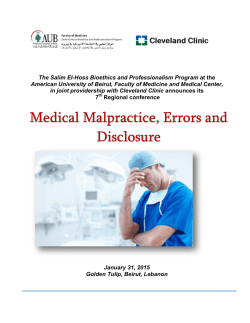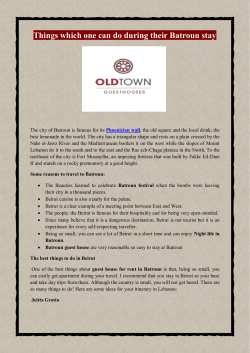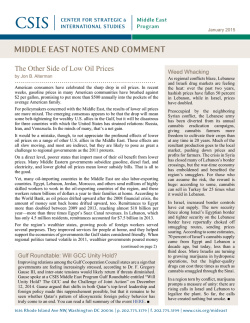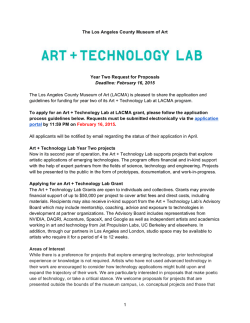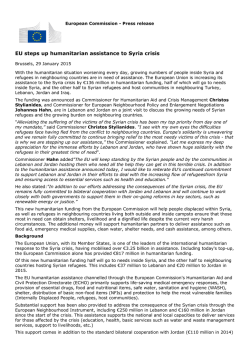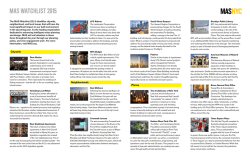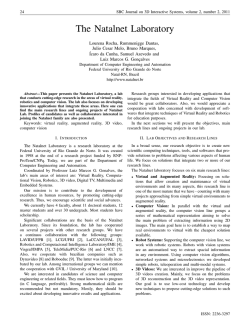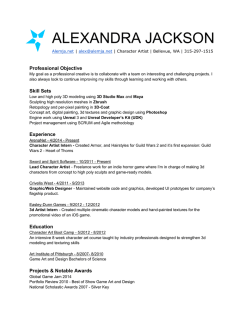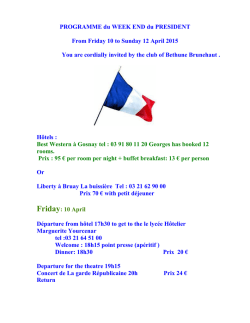
Check auction catalogue
A MUSEUM IN THE MAKING Benefit Auction Friday 30 January 2015 10.00 pm - Casino du Liban Supported by A MUSEUM IN THE MAKING Benefit Auction Friday 30 January 2015 10.00 pm - Casino du Liban CREDITS Front cover and backcover: lot #05 (detail) Inside front cover and page 01: lot #21 (detail) Page 02: lot #06 (detail) Pages 08: lot #19 (detail) Inside back cover: lot #13 (detail) Supported by A M U S E U M I N T H E M A K I N G 04 A MUSEUM IN THE MAKING Dear Friends, Lebanon has always been home for free ideas, progressive thinkers, pioneer movements and artistic expression. A new narrative is taking shape in the region, regardless of the uncertainties surrounding us. As this dynamic progresses, how do we remain viable in sustaining our freedoms and tolerance and in preserving an outlook of diversity, pluralism and inclusiveness? Beirut Contemporary is a pioneering new museum of modern and contemporary art in Lebanon. Developed by APEAL in conjunction with a network of Lebanese and international partners, the museum will stand on a site donated by the Université de Saint Joseph, at Beirut’s thriving Mathaf intersection. Art is the highest measure of our universal humanity and of the spirit of civilizations, which endure in perpetuity. It stems from our innermost truths, our darkest fears and addresses our hopes and dreams. Art, in all its forms, remains the lasting footprint in the history of nations and people. Artists in Lebanon have survived against the odds and the turmoil of these last few decades. Their innovation and fearlessness have led the way through the dim tunnels of adversity and circumstance. With a new world-class museum, we want to give them and their brave, intrepid journey a home. We want Beirut Contemporary to be a temple of delight, wonderment and discovery for art lovers from around the world. It will not just be a repository of works of art, but a vibrant platform for change, artistic ferment and evolution. It will not only exhibit modern and contemporary art but will also feature performance art and develop capabilities for restoration, research and education as well. Taking a leaf out of the book of museums and art institutions around the world, striving to remain in synch with their communities and urban communities and to become vehicles for change and enrichment, we will engage with our environment in the most dynamic way. To survive and continue attracting the generations building our future, museums have to adapt and stay in tune with the times. Ours will be no different. Its content and message will not be static but fluid and interactive. In the past year, the Association for the Promotion and Exhibition of the Arts in Lebanon has been actively working with Lebanese and international consultants to draw up a comprehensive vision and blueprint for the museum’s mission, function, governance structure, capital and operational costs and business plan. Our endeavor and efforts are geared towards making Beirut Contemporary a focal point and epicenter of cultural and creative ferment, along a line of emerging and new museum. It stretches from the National Museum, through Beirut Contemporary, to Lebanon’s Prehistoric Museum at the Université St. Joseph, the recently opened and impressive Mineral Museum, also associated with the Jesuit University, the planned Beit Beirut, House of Beirut, and others. Beirut Contemporary will be a window onto Lebanon’s cultural and artistic potential and offer an open view to those of the region. Lebanese architects are busy coming up with various designs that will best fit and showcase the museum’s purpose and style. A select jury will announce the competition’s final result in due time. Though public and private sources of funding in other countries have shared the burden of subsidizing and sustaining museums, the Lebanese government has been weighed down with other priorities. Over-taxed infrastructure, political discord and a massive influx of refugees have sucked up all public resources of assistance to the arts. APEAL has taken it upon itself to shoulder what it sees as a sacred and decisive responsibility. We invite and urge you to join us in bringing this very important venture to fruition. Beirut Contemporary will have a crucial role in preserving unity and rallying the nation and the region around change, progress and a plurality of fresh ideas. You have a role in making this happen, in raising awareness and sensitivity towards inclusiveness and minority communities to the highest levels. We do this by acknowledging our realities through artistic and cultural expression and by projecting how we see ourselves, and how the rest of the world can perceive us. “ “ foreward Sincerely, Henrietta Nammour President of APEAL A generation on from the end of the Lebanese civil war, a rich and substantial artistic community exists in Beirut, with Lebanese talent increasingly celebrated and collected across the international art world. Despite regional instability, the tenacity of Lebanese artists, curators, thinkers and activists has generated a vibrant local scene. Grown from grass-roots, it is defined by innovation and fearlessness. However, major governmental support for artists does not yet exist in Lebanon. Nor does an internationally-recognized contemporary museum. Beirut Contemporary will fill this space, a twenty-first century museum that aims to contribute to meaningful art discourse in Lebanon and beyond, and form strong and lasting relationships with its local communities. Open to all, the museum will be actively shaped by the communities it serves, and enter into dynamic dialogue with the vibrant and diverse publics that make up Beirut. Art and culture are catalysts for economic regeneration, on city-wide and regional levels. Museums generate revenue and stimulate local economic activity, raising the value of real estate and creating varied and stable jobs in an increasingly knowledge-based economy. More conceptually, art institutions contribute to a sense of place and belonging, becoming sources of pride and national identity. Beirut Contemporary hopes to be a vehicle for sharing Lebanese values and ideals, connecting with the Lebanese diaspora and promoting peaceful dialogue through the power of the visual and performing arts. Building a core collection that reflects the strength and diversity of Lebanese art, Beirut Contemporary’s exhibitions will bring Middle-Eastern artists of the twentieth and twenty-first centuries into dialogue with international art contexts. Featuring state-of-the-art galleries, performance spaces, library and archive, Beirut Contemporary is dedicated to nurturing the next generation of artistic and curatorial talent, in Lebanon, the Middle-East, and beyond. As an independent institution, Beirut Contemporary aims to be a stable site for the creation of art discourse, public education and community engagement. 05 Guest Speaker Lord (Peter) Palumbo G N I K A M E H T N I M U E S U M A He is a trustee of the Visiting Committee of the Mies van der Rohe archive at the Museum of Modern Art in New York and The Design Museum in London. He has served as a trustee of the Tate Gallery in London and six other institutions and foundations. He is chairman and Chairman Emeritus of the Serpentine Gallery in London and was chairman of the Pritzker Prize for Architecture from 2010-2012. He was appointed as chairman of the Arts Council in Great Britain from 1994-2014 and as chairman of the Tate Gallery Foundation in 1985-1986 and he is currently the chairman of the Royal Fine Art Commission Trust among others. Lord Palumbo was a board member of the Andy Warhol Foundation in New York, The Royal Albert Hall in London and of The Royal Shakespeare Company, among others including member of the advisory board to the Lebanese International Finance Executive. He has been awarded no less than eight titles and honors for his many achievements in his working life and the arts. He was chancellor of the University of Plymouth from 1992-2007, governor of The London School of Economics from 1976-1994 and of the Whitgift School in England from 2002-2010. He has written for various publications on subjects related to the arts and architecture and lectured and spoken publically at a host of venues, academies and universities. “ The impact of a Modern and Contemporary Museum of Art of quality upon the inhabitants of the town or city in which it is located, is best demonstrated by the City of Bilbao in Spain, with the advent there of the Guggenheim Museum. Before that great event, the city had been riven by turmoil, violence, and dissent. Since its completion, however, these negative qualities have been replaced by the three Rs, - reconciliation, rehabilitation, and regeneration. And why not? The Arts, after all, have the capacity to transcend physical boundaries, as well as boundaries of language, race, colour, religion and class, by virtue of the fact that the talent of artists represents at its best, the highest achievement of which the human spirit is capable. No wonder that the Arts are also a yardstick by which the civilised nature of any society can be, and is, measured, introducing in the process, pride and hope, both of which are precious components of contemporary life. In fact, of course, this same sense of pride and hope have worked their magic since the beginning of time. Because of an antiquity that stretches back many millennia, Lebanon finds itself in the forefront of Middle Eastern culture. Add to that the legendary financial brilliance of its people, and their equally legendary resilience, and the winning formula is complete! If Antiquity gives Lebanon a head start in matters of cultural excellence, that long and noble pedigree has endowed the DNA of its people with the same aura, whether they are aware of it, or not. And as a result, they have no need to clothe their culture in superficial glitter, or the cosmetic fashion of the moment: no need to market their work for instant consumption or to stunt their stuff that some might categorise as arrogance, because they know that money can never be a substitute for talent; and that no amount of money can buy heritage or tradition. So the Lebanese approach will be of a very different order – an article of faith in the modern world: a witness to contemporary history; a repository of events, some shattering, other sublime. And because artists are free agents of perception who have the capacity to see and to convey, they are able to capture the moment in all its horror or glory as an expression of living memory. The social, educational, and economic benefits that will follow such an enterprise are boundless; and they will add a new, and fresh dimension to the life of Lebanon, - exciting, exhilarating, as only a celebration of the truth of positive energy can provide. Crowds will flock to the Museum from within the country, and from all four corners of the globe, for Beirut has always been a powerful and joyful beacon, and a destination that has no need to look for an audience, or to offer inducements to sample its wares. What it will offer will be a transformative experience through the medium of artistic excellence that will speak without fear or favour. It will also play a leading role in strengthening the creation production, distribution and enjoyment of culture and services at the local and regional level. In these troubled times of economic fear, uncertainty, and dislocation, it is essential to record, and not only to record, but to emphasise once again, that the Arts speak a universal language that is, in every way, an indispensable adjunct to any potential initiative, in furthering international relationships and understanding; bringing harmony where there is discord; hope where there is despair; light where there is darkness; and creativity where there is chaos. Let this development for Beirut and Lebanon be the beginning of something bold, beautiful, and brave: And let us all resolve to work together to ensure that this Modern and Contemporary Museum of the Arts becomes a reality. “ 06 Baron Palumbo of Walbrook, an Eton and Oxford graduate, studied law, rose to prominence as a successful developer and became an avid art collector and dedicated patron, with a lifelong passion and appreciation for fine architecture. He has commissioned designs by the late Sir James Stirling and Mies van der Rohe, both celebrated and world known architects, for prestigious and historic sites and memorials in the United Kingdom and the United States. In 1972 and 1986, he commissioned sculptures and a sundial by Henry Moore and half a dozen works of art by other leading artists and designers. He secured the purchase of properties owned buy Frank Lloyd Wright and van der Rohe in America and oversaw their embellishment and opening to the public. Peter Palumbo 6 January 2015 07 APEAL Pride Award Raymond Wadih Audi An annual prize presented to an individual for outstanding achievement and distinguished service rendered in one of the fields of promoting culture and raising the profile of Lebanese art at home and abroad. The criteria for selection are based on the highest standards of excellence and professionalism in sensitizing audiences to great discoveries, advances and novelties from various facts of the cultural realm of Lebanon and beyond. Raymond Audi is the essence and epitome of a renaissance man. He is not only a giant in the banking business, but also an entrepreneur, a philanthropist, a keen patron of the arts and a true patriot with an eye for the aesthetic and a reverence for culture and its role in the preservation of civilizations. A banker by profession and training, he was instrumental, alongside his father and brothers, in the development of a centenarian family enterprise, which culminated in Banque Audi in 1962. He engineered the early development of the bank, establishing the first merchant bank in Lebanon and then presiding over the local, regional and international expansion of the Banque Audi brand with eight subsidiaries abroad, in France, Jordan, Syria, Egypt, Sudan, Saudi Arabia, Qatar, Monaco and Turkey. The bank grew steadily and its impact beyond Lebanese borders buoyed its standing as one of the top 20 Arab banks. Banque Audi has alternatively also topped the list of Lebanese banks and maintained its leading and dynamic role in consolidating the Lebanese banking sector despite Lebanon’s turbulent history. Audi’s benevolent reach and contribution is outstanding. He is a founding member of the Executive Committee of the Chronic Care Center and has also served as its treasurer since 1993. He is also a board member of the Notre Dame de Jamhour and the Lebanese American University. He founded the Fondation Nationale du Patrimoine, Lebanon’s National Heritage Foundation and is an emeritus member of the Board of Trustees of International College. He is one of the founding members of the St. Jude Children’s Research Hospital, a children’s cancer center, and founder of the Audi Foundation, which is dedicated to the promotion, relaunching and appreciation of the professions of craftsmanship and the restoration of historical sites, urban spaces and streets, especially in the port city of Sidon. He strives to boost the spirit of entrepreneurship as a member of Injaz, a non-governmental organization. He finances some 20 scholarships a year based on merit. He has contributed to UNICEF, the Chronic Care Center, the United Nations Development Program and Saint Jude’s Research Hospital and the Foyer de la Providence. He has been awarded no less than 15 honors and distinctions in Lebanon and around the world. Audi has encouraged art and the universe of artists by transforming his banks into resplendent museums and showcases for great architecture. The headquarters of Banque Audi in Switzerland houses an impressive collection of seventeenth century masterpieces. The new flagship headquarters of Audi Plaza Beirut is a feast for the eyes. It is considered a unique treasure and gem with its facade in the downtown area that was built by Lebanese and European architects. It has on exhibit one of the finest and richest collections of Lebanese and French painters such as Jacques Villon, Edward Vuillard, Gaston Chaissac, Raoul Dufy, Francois Rouan, Marwan Bachi and scores of others. * APEAL Pride Award sculpture by Nadim Karam 09 Master of Ceremony Christie’s Auctioneer Ali Jaber is a prominent Lebanese journalist and TV personality, and is currently the Group TV Director of MBC, the Arab world’s largest satellite broadcaster. In over 30 years as an auctioneer at Christie’s, Hugh has conducted more than 2,200 auctions, selling 290,000 lots for a total sum in excess of £1.85 billion. The highlight of his career in the rostrum came in Hong Kong in November 2014 when he sold a 15th Century Chinese Imperial embroidered silk Thangka for HK$348 million (£28.9 million), the world record for any Chinese work of art sold by an international auction house. Ali Jaber As a journalist, Mr Jaber had the opportunity to interview the late Rafic Hariri, who would become Prime Minister in 1992. It was Mr Hariri who approached Jaber to set up Future TV, the Hariri television network, which is still in operation today. A decade later, Jaber was invited by Sheikh Mohammed bin Rashid al-Maktoum, Vice President of the UAE and Ruler of Dubai, to work as a media consultant involved in restructuring the TV operation of the government-owned Dubai Media Incorporated, and to revamp and re-launch its four national pan-Arab satellite channels. In 2008 Jaber was invited by the Sheikh to set up a Communication School at the American University in Dubai, and was named Dean of Mohammed Bin Rashid School of Communication, which this year graduates fifty students with degrees in Journalism and Digital Storytelling. The school is unique in teaching all media writing courses in Arabic. Jaber also serves on the Board of Directors of two non-governmental organizations, the Clinton Global Initiative and Young Arab Leaders, and is currently an ambassador for SANAD, a home hospice association in Lebanon. A M U S E U M I N T H E M A K I N G 010 After studying Business Administration at the American University in Beirut as an undergraduate, Mr Jaber moved to New York to study for a Master’s degree in Communication at Syracuse University. In 1986 he returned to Lebanon, at a time when many others were fleeing the country and the civil war. His career in journalism began soon after he arrived, when he picked up work as a war correspondent for The New York Times, The Times and the German Press Agency, and joined the Fine Arts faculty of Beirut University College. He helped set up their Broadcasting Department and taught a range of courses in television production. Jaber spoke at the TEDxBeirut conference for inspirational leaders in 2011, an address about the official launch of The Global Classroom, a project he established at the American University in Dubai in partnership with the company Cisco. It is the first such initiative in the Arab world that gives students access to the best professors, business leaders and guest lecturers located around the globe, online. Jaber’s current role is as Group TV Director of MBC, a post he has held since September 2011. He is in charge of MBC’s 13 television channels, and serves as a celebrity judge on popular television show, Arabs Got Talent. He is currently studying for a PhD in the history of satellite television in the Arab world, at Cambridge University, and has been named as one of the 500 Most Influential Muslims in the world by the Royal Islamic Strategic Studies Centre, an independent non-governmental research entity. Hugh Edmeades Hugh has auctioned works of art from a number of historic collections including those of H.R.H. the late Princess Margaret, the Spencer collections at Althorp, the collection of the late Simon Sainsbury and in December 2011, part of the Elizabeth Taylor Collection in New York. Further interesting and unusual highlights have included Audrey Hepburn’s “Breakfast at Tiffany’s” dress which sold in December 2006 for £467,000; the oldest existing F.A. Cup which sold for £478,400 in May 2005 and Ursula Andress’s bikini from James Bond’s Dr No for £41,000 in February 2001. Hugh is a much sought after auctioneer for high-profile national and international charity auctions and throughout his career has conducted over 600 sales raising in excess of £70 million for charitable causes. Hugh has conducted charity auctions all around the world, including in Bahrain, Chandigarh, Moscow, New Delhi, Paris, New York, Geneva, Monaco, Dubai, Beirut, Zurich, Doha, Los Angeles, Hong Kong, Mumbai, and Casablanca. In 2005, he was chosen to conduct the BBC’s inaugural televised celebrity auction in aid of Children in Need. In 2008, he conducted the auction for Nelson Mandela’s 90th Birthday Gala in London, selling the eight lots for a total of £4.3 million. Hugh joined Christie’s in 1978 as a furniture specialist. In 1984, he became Head of the Furniture Department at Christie’s South Kensington and in the same year conducted his first auction. In 1990, Hugh became Director of Specialist Departments and then after three years as Deputy Chairman, he was appointed Chairman of Christie’s South Kensington in 1999. In 2006 Hugh was appointed as Christie’s International Auctioneer. 011 A MUSEUM IN THE MAKING Benefit Auction /21 Lots 013 AUCTION Friday 30 January 2015 10 pm Casino du Liban Jounieh, Lebanon VIEWING Quantum House, 164 Sursock Saturday 24 January Sunday 25 January Monday 26 January Tuesday 27 January Street, Achrafieh, Beirut, Lebanon 3.00 3.00 6.00 6.00 pm pm pm pm – – – – 7.00 7.00 9.00 9.00 pm pm pm pm AUCTIONEER Hugh Edmeades CONTACT INFO Nada Al-Assaad Maria Geagea Arida +961 3 234 264 +961 3 256515 CONDITIONS OF SALE No buyer’s premium or any additional taxes Supported by #01 Omar Onsi (b.1901) Landscape Signed (lower left) Oil on panel 40 x 43 cm circa 1935 Courtesy of a Private Collector $15,000 - 25,000 A M U S E U M I N T H E M A K I N G 014 Omar Onsi was a Lebanese artist who, after an attempt to study medicine, learnt to paint with Khalil Saleeby. From 1922 to 1927, he travelled to Transjordan, where he taught painting and English to the children of King Abdullah. The discovery of the desert and its colors during this stay had a major influence on Onsi’s work. In 1928, Onsi went to Paris to continue his training, where he remained for three years, attending the Académie Julian and different workshops. During this period, Onsi focused on painting portraits, nudes, and Parisian scenery. In 1933 he returned to Lebanon, bringing back a colorful Impressionist palette. From then on, his work focused on the Lebanese landscape. Omar Onsi stands apart among the “founding fathers” of Lebanese painting because his life was so entrenched in his art that there is scarcely anything for a biographer to extricate. Furthermore, the art itself was wholly blended with the light and landscape of his country, with the humanity of a traditional Lebanon. This approach is fixed in his portraits, little genre scenes, and images of a wonderfully happy land on which he fastened his gaze and bestowed devotion. Onsi died in 1969, and has since become one of Lebanon’s best-known artists. #02 César Gemayel (b.1898) Portrait of a Woman Signed (lower left) Oil on board 50 x 40 cm circa 1940 Courtesy of a Private Collector $ 9,000 - 12,000 A M U S E U M I N T H E M A K I N G 016 César Gemayel was born in 1898 at Ain al-Touffaha near Bikfaya. As a young student, Gemayel started out studying pharmacology, to which he was genuinely devoted. But he was a gifted painter and, taught by Lebanese master painter Khalil Saleeby, it was art that he made his life’s work. Gemayel was most attracted to Impressionism and Fauvism, and his work and talent were recognized in 1931, when he won first prize at the Paris Exhibition Coloniale Internationale. The prestigious award set Gemayel firmly on an artistic path; he returned to his native Lebanon, abandoned any thoughts of being a pharmacist and turned his full attention to developing his painting. Enamored with his country, Lebanon was Gemayel’s main inspiration, its mountains, villages, folk life, city streets and people. All these subjects fed his love of color, working in strong shades of red, green and blue. Gemayel died suddenly in 1958, and stands among the second generation of the founding fathers of Lebanese painting, inspiring many who came after him. #03 Habib Srour (b.1860) Nu Académique Oil on canvas 52 x 60 cm circa 1885 Courtesy of a Private Collector $ 8,000 - 12,000 A M U S E U M I N T H E M A K I N G 018 Born in Lebanon in 1860, Habib Srour was 10 years-old when his parents moved to Rome, where he went on to study at the Institute of Fine Arts. Srour was an important figure in the artistic renaissance that emerged in Lebanon at the end of the nineteenth century. He is credited with pioneering principles of Modernist artistic practice, using light, shadow and form in an expressive and evocative manner. Srour was much in demand as a portrait painter of prominent Lebanese and Arab social, political and religious figures of the Ottoman Empire. As with all the artists of his generation, Srour was faithful to the classical school, but this did not prevent him from breaking out of the narrow framework of Formalism in order to give himself some liberty in the choice and treatment of his subjects. In his religious commissions, which were highly sought-after, the artist adopted a more conservative approach. It is his portraits, more experimental and expressive, for which he is best known. Habib Srour died in 1938, but his work is as relevant today in the world of art as it was 95 years ago. #04 Elie Kanaan (b.1926) Untitled Signed (lower left) Oil on canvas 40 x 50 cm circa 1985 Courtesy of the Elie Kanaan Family $15,000 - 20,000 A M U S E U M I N T H E M A K I N G 020 Born in Beirut in 1926, Elie Kanaan is a self-taught artist whose artistic abilities were evident from a young age. Throughout the 1950s and 1960s he studied and travelled to Paris and Italy before returning to Lebanon. In 1957 he won first prize at the Salon du Printemps, and the UNESCO prize in 1958. From 1962, Kanaan participated in many individual and group exhibitions – biennales, art fairs and salons worldwide – as well as receiving a variety of awards. These included a prize from the Lebanese President of the Republic, the Philips prize, the Vendome Prize in 1967, and two from the Sursock Museum. Kanaan also served as Professor at the Lebanese Academy of Art. #05 Shafic Abboud (b.1926) Untitled $ 80,000 - 120,000 A M U S E U M I N T H A K I N G M Signed and dated (lower right and on the reverse) Tempera and oil on panel 80 x 100 cm 1958 To be included in upcoming catalogue raisonné under Id1849 Courtesy of the Shafic Abboud Family E 022 Born in Lebanon in 1926, Chafic Abboud graduated from the Lebanese Academy of Fine Arts in 1947. After moving to Paris, he frequented André Lhote’s workshop and was a pupil of the Cubist master Fernand Léger. In 1952 he enrolled at the prestigious Ecole Nationale Supérieure des BeauxArts where he studied drawing and engraving. In 1959, Abboud participated in the first Paris Biennale. He was awarded the Prix Victor Choquet in 1961, and granted solo exhibitions in France, Lebanon, Italy, Germany, Holland, and Denmark. His works feature in the permanent collection of the Centre Georges Pompidou in Paris and hang in French government buildings. A catalogue raisonné of Abboud’s work has recently been published by the Gallery Claude Lemand, Paris. A major retrospective of the artist at the Institute du Monde Arabe, Paris, in 2011, shed light on more than 190 works spanning his entire painting career (1948-2003). The Beirut Exhibition Center presented another extensive retrospective of Abboud’s work in 2012. Abboud lived in Paris until he passed away in 2004. #06 Shafic Abboud (b.1926) Untitled $ 40,000 - 60,000 A M U S E U M I N T H A K I N G M Signed and dated (lower right) Mixed media on paper laid on canvas 50 x 60.5 cm 1959 To be included in upcoming catalogue raisonné under Id1691 Courtesy of the Shafic Abboud Family E 024 Born in Lebanon in 1926, Chafic Abboud graduated from the Lebanese Academy of Fine Arts in 1947. After moving to Paris, he frequented André Lhote’s workshop and was a pupil of the Cubist master Fernand Léger. In 1952 he enrolled at the prestigious Ecole Nationale Supérieure des BeauxArts where he studied drawing and engraving. In 1959, Abboud participated in the first Paris Biennale. He was awarded the Prix Victor Choquet in 1961, and granted solo exhibitions in France, Lebanon, Italy, Germany, Holland, and Denmark. His works feature in the permanent collection of the Centre Georges Pompidou in Paris and hang in French government buildings. A catalogue raisonné of Abboud’s work has recently been published by the Gallery Claude Lemand, Paris. A major retrospective of the artist at the Institute du Monde Arabe, Paris, in 2011, shed light on more than 190 works spanning his entire painting career (1948-2003). The Beirut Exhibition Center presented another extensive retrospective of Abboud’s work in 2012. Abboud lived in Paris until he passed away in 2004. #07 Paul Guiragossian (b.1926) Untitled Signed (lower right) Watercolor on paper 73 x 52 cm 1980 “Gebraniyyet” Series. Certificate of authenticity from Guiragossian Foundation Courtesy of a Private Collector $15,000 - 25,000 A M U S E U M I N T H E M A K I N G 026 One of Lebanon’s most celebrated artists, Paul Guiragossian was born in 1926 in Jerusalem, to Armenian refugee parents. In 1939 the family moved to Beirut, where he lived until his death in 1993. Guiragossian started to paint in 1942 at the Yarcon Studio, and began his artistic training in 1944 at the Italian Academy Pietro Langhetti. In 1956 he received a scholarship to study at the Academy of Fine Arts in Florence, after which he spent many years studying and painting in Paris and the United States. His work is present in many collections throughout the Middle East and across the world, including that of the Vatican Museum. #08 Alfred Basbous (b.1924) Abstract $10,000 - 15,000 A M U S E U M I N T H A K I N G M Signed and dated (on the base) Bronze with gold patina 20 x 40 x 26 cm 1972 Edition 6/8 Courtesty of the Alfred Basbous Family E 028 Born in Rachana, Lebanon, in 1924, three years following the birth of his brother Michel, Alfred Basbous had a peripatetic childhood. His family moved around, living among different communities, as his father was a parish priest. Alfred worked with stone early on, and began carving works in wood and metal too, primarily to represent animals and female nudes. In 1960, he received a scholarship from the French government and became a pupil of the sculptor René Collamarini at L’Ecole Nationale Supérieure des Beaux-Arts in Paris. In 1961, his works were included in the International Sculpture Exhibition at the Musée Rodin, Paris. Returning home, Alfred drew inspiration from the Modernism of Auguste Rodin, Henry Moore and Jean Arp, as well as the nature of Lebanon, reflected in his work on the human body and feminine curves. #09 Michel Basbous (b.1921) Dancer $ 30,000 - 40,000 A M U S E U M I N T H A K I N G M Signed (on the base) Bronze 96 x 21 x 21 cm 1952 Edition 6/8 Courtesy of the Michel Basbous Family E 030 Michel Basbous was born in Rachana, Lebanon, in 1921. Between 1945 and 1949 he studied sculpture at the Academie Libanaise de Beaux-Arts in Beirut. Between 1949 and 1951 he studied at L’Ecole Nationale Supérieure de Beaux-Arts in Paris, on a scholarship from the Lebanese government. He went back to Paris to study in the atelier of Ossip Zadkine between 1954 and 1955. In 1957 he became a Professor of Sculpture at the American University of Beirut, and returned to his native village of Rachana in 1958, where he exhibited his sculptures and turned Rachana into an artistic and cultural center. He married Therese Aouad, a poet and an author in 1967. They had their only child Anachar (“Rachana” spelled backwards) in 1969. After a fruitful life, Michel Basbous passed away in 1981. At a time when the country was revisiting its heritage, his oeuvre questioned the spread of modernity. #10 Dia Azzaoui (b.1939) Imaginary Plant $ 30,000 - 40,000 A M U S E U M I N T H A K I N G M Signed (on the base) Bronze 51 x 49 cm 2014 Edition 3/7 Courtesy of the artist and Galerie Claude Lemand E 032 Born in Baghdad in 1939, Azzawi studied art and archeology at the Faculty of Arts at Baghdad University. 1965 represents many of Azzawi’s promising firsts, though it was by no means his career’s zenith: his first solo exhibition was held in Baghdad; his first two collective exhibitions, one of which toured Beirut, Rome, Vienna, and Madrid; and his first international exhibition at the Premiére Triennale of International Art in New Delhi. In 1976 Azzawi was appointed Art Consultant at the Iraqi Cultural Centre in London. His work organising exhibitions for Arab and Iraqi artists at the Center was instrumental in introducing Arab art to the British public. The Museum of Modern Art, Baghdad; Victoria and Albert Museum, London; Library of Congress, Washington D.C.; and Arab Monetary Fund, Abu Dhabi comprise a few of the many public collections in which Azzawi’s works hang. He now lives in London where he is an artist-collector, and he regularly publishes his commentary on Iraqi contemporary art and Arab art. Azzawi’s epic drawing Sabra and Shatila Massacre, 1982-83, is currently on view at Tate Modern in London. #11 Jamil Molaeb (b.1948) قرية البيئة البيضاء Signed (lower right) Oil on canvas 155 x 110 cm 2014 Courtesy of the Artist and Galerie Janine Rubeiz $10,000 - 15,000 A M U S E U M I N T H E M A K I N G 034 Jamil Molaeb was born in Lebanon in 1948. Trained under some of the most distinguished Lebanese Modernist painters, Jamil Molaeb’s signature paintings conceive of the abstract color field as a traditional landscape, evoking through those minimal pictorial frameworks the magic simplicity of miniatures and icons. Molaeb has the unique ability to marry diverse techniques, for instance folkloric woodcuts with a bright, Expressionist palette. Molaeb has featured in myriad solo and group exhibitions in Lebanon, Algeria, and the United States since 1966, including a number of art fairs: Art Abu Dhabi, Beirut Art Fair, Art Dubai and Art14 London. He has published four books, including Xylographies-Woodcuts with Galerie Janine Rubeiz in 2014. His work has been acquired by public and private collections including The World Bank in Washington D.C. Molaeb holds a Master’s degree from the Pratt Institute in New York and a PhD in Art Education from the University of Ohio. He was formerly Professor of Art at the Lebanese American University and the Lebanese University. #12 Chaouki Chamoun (b.1942) I Invent Peace When I Do Not Find it Signed and dated (lower left) Acrylic on canvas 160 x 145.5 cm 2014 Courtesy of the artist $ 40,000 - 60,000 A M U S E U M I N T H E M A K I N G 036 Chaouki Chamoun was born in Lebanon in 1942. In 1972 he received his Diploma of Higher Studies in Painting from the Lebanese University in Beirut. The first in his class, he was awarded a six-year fellowship from the Lebanese University to pursue his graduate studies in the United States. In 1975, he received his MFA from Syracuse University in New York, followed by a PhD in Art Education from NYU, from which he was awarded a Meritorious Commendation for High Scholastic Achievement. He has had over thirty solo shows since 1975, and has participated in over fifty group exhibitions and biennales including at Rochester Memorial Museum, Sursock Museum, Al-Khorafi International Arabic Biennale (2006), Alexandria Biennale (2008) and the Katzen Art Museum. His work is also held in several public and private art collections. #13 Nabil Nahas (b.1949) Tyrian Purple Signed (on the reverse) Acrylic on canvas 122 x 122 cm 2009 Courtesy of the artist $100,000 - 150,000 A M U S E U M I N T H E M A K I N G 038 Nabil Nahas was born in Beirut in 1949, but spent the first ten years of his life in Cairo, before his family returned to Lebanon. In 1969 he arrived in the United States for Undergraduate studies, having grown up familiar with Western culture – especially the art and literature of France. Nahas also has vivid memories of the books and catalogues that gave him his first exposure to the abstract painting of post-war New York. He received degrees from Louisiana State University in 1971 and Yale University in 1973. Since then he has built a reputation as one of America’s foremost contemporary artists, with many solo shows, first at the Robert Miller Gallery, New York; Gallerie Montenay, Paris; Sperone Westwater, New York; and Gallerie Xippas, Paris. He has participated in several group exhibitions, including the Basel Art Fair, 1979, and the XXVth Bienal de São Paulo, 2002. #14 Azade Köker (b.1949) Beyrut Signed (on the reverse of the right panel) Mixed technique on canvas Diptych (each 170 x 250 cm) 2014 Courtesy of the artist and Galeri Zilberman $150,000 - 200,000 A M U S E U M I N T H E M A K I N G 040 Azade Köker was born in Istanbul in 1949. She is an academic, a painter and installation artist from Turkey, currently residing in Germany. Her dual nationality has defined her work and identity as an artist with a multicultural background – reflected in her multi-faceted work with photography, ceramics, installation and painting. After completing her studies at the Istanbul Academy of Fine Arts in 1971, Köker pursued further studies at the Berlin School of Fine Arts in the Department of Industrial Design and the Department of Sculpture. Since the early nineties, Köker has been teaching in several Universities in Germany and is currently a professor at the Braunschweig Technical University. Her first exhibitions were held in the 1980s and she continues to exhibit her work at a global level today. Right panel #15 Akram Zaatari (b.1966) Untitled (Plane 6) Archival inkjet print 145 x 100 cm 2013 Courtesy of the artist and Sfeir Semler Gallery $15,000 - 20,000 A M U S E U M I N T H E M A K I N G 042 Born in 1966, Zaatari is one of Lebanon’s most globally-renowned contemporary artists. Zaatari’s practice reflects on the shifting nature of borders and the production and circulation of images, in the context of the current political divisions in the Middle-East. His videos and photographic installations explore notions of surveillance, and the deployment of technology in the service of power, resistance, and memory. As co-founder of the Arab Image Foundation, Zaatari is deeply invested in examining how photography serves to shape notions of aesthetics, postures and social codes, looking at the present through a wealth of past photographic records from the region. Zaatari has been focusing since 1999 on the archive of Studio Shehrazade in Saida, Lebanon, studying, indexing, and presenting the work of photographer Hashem el-Madani, as a register of social relationships and photographic practices. Zaatari represented Lebanon at the Venice Biennale in 2013 with Letter to a Refusing Pilot. #16 MARWAN SAHMARANI (b.1970) The Crying Man $18,000 - 25,000 A M U S E U M I N T H A K I N G M Signed (lower right) dated (on the reverse) Oil on canvas 170 x 150 cm 2014 The last painting (IV) of the series painted exclusively for this auction Courtesy of the artist E 044 Marwan Sahmarani was born in Beirut in 1970, and graduated from the Atelier Met de Penninghen in Paris, France in 1989. Sahmarani has participated in a variety of solo exhibitions in London, Dubai, Canada and Beirut as well as group exhibitions in Munich, Washington D.C. and Mexico. His most recent group museum exhibitions are Told/Untold/Retold at the Arab Museum of Modern Art, Doha, Qatar in 2010 and The Feast of the Damned at the Museum of Art & Design, New York, USA in 2010. Sahmarani was also one of three recipients of the prestigious Abraaj Capital Art Prize in 2010. #17 Oussama Baalbaki (b.1978) Untitled Signed and dated (lower right) Acrylic on canvas 150 x 150 cm 2014 Courtesty of the artist and Agial Gallery $10,000 - 15,000 A M U S E U M I N T H E M A K I N G 046 Born in Beirut in 1978, Oussama Baalbaki graduated with honors in 2002 from the Lebanese University School of Fine Arts. In 2009, he received the Silver Medal in Painting at the International Jeux de la Francophonie, in which he represented Lebanon. He has had four solo exhibitions since 2004, including a show at Agial Gallery, Beirut, and more recently, a painting exhibition hosted by FFA Private Bank in Lebanon. Baalbaki has participated in various group exhibitions in Dubai, Lebanon, Qatar, Germany and the US. He now lives and works in Beirut. #18 Abdulrahman Katanani (b.1983) Splendor in the Grass Signed (on the reverse) Mixed media on canvas 140 x 380 cm 2014 Courtesty of the artist and Agial Gallery $20,000 - 30,000 A M U S E U M I N T H E M A K I N G 048 Abdul Rahman Katanani is a Palestinian artist born in Beirut in 1983. He graduated with a degree in Fine Arts from the Lebanese College, where he also achieved an MA in Painting. Katanani has lived all his life as a refugee in Shatila camp, Lebanon. He has been exhibiting in caricature and fine art shows in Beirut, Paris and Kuala Lumpur since 2001. He was twice awarded a prize by the Sursock Museum at the occasion of their Salon d’Automne in 2009, and has also received the Young Artist Prize, and a Special Mention from the Jury in 2008. Katanani is currently attending a 15 months residency at La Cité Internationale des Arts, Paris. Detail #19 Nadim Karam (b.1957) “The Urban Zoo” Signed (lower right) Mixed media on canvas 140 x 205 cm 2013 Courtesy of the artist and Ayyam Gallery $ 20,000 - 30,000 A M U S E U M I N T H E M A K I N G 050 Born in Senegal in 1957, Nadim Karam is a multidisciplinary artist. A prominent figure in the Lebanese art scene, he graduated from the American University of Beirut and received graduate and postgraduate degrees from the University of Tokyo, Japan. Karam has exhibited in galleries and institutions internationally, contributing to such notable events as the Liverpool Biennale, the Venice Biennale and the Gwangju Biennial in South Korea. His works are housed in corporate and cultural foundations in the Arab World and Europe, Asia, and Australia. In 1996, he established l’Atelier Hapsitus, a studio that he defines as “the satellite grouping of young architects and designers around happenings and situations.” Atelier Hapsitus has become a vehicle for Karam’s unique oeuvre, boasting a number of works and projects that blend architecture, design and art. His sculptural series, entitled Closets & Closets was on display at the Institut du Monde Arabe, Paris, in 2012-2013, while Ayyam Gallery, London presented his solo show Shooting the Cloud for their grand opening in January 2013. #20 Marwan Kassab Bachi (b.1934) Marionette 1 Signed (on the reverse) Pencil and gouache on paper 21 x 30 cm 2007 Courtesty of the artist and Sfeir Semler Gallery $ 6,000 - 8,000 A M U S E U M I N T H E M A K I N G 052 Born in 1934 in Damascus, Syria, Marwan Kassab Bachi, known as Marwan, is one of the most distinguished Syrian artists. After studying Arabic Literature in Damascus, he moved to Germany in 1957. He undertook a degree in Painting at the Higher Institute of Fine Arts in Berlin under the supervision of Hann Trier, where he later became a teacher. He was granted a permanent Chair at the University since 1980. He founded the Summer Academy at Darat Al-Funun (under the patronage of Suha Shoman) Art Foundation in Jordan in 1999. From 1967 until the present, Marwan has exhibited widely across the world, predominantly in Germany, France, the USA, and Syria. He was offered a scholarship from the Cité des Arts, Paris in 1973, and granted the Karl Hofer (1966) and Fred Thieler (2002) awards, the Merit Order of the Federal Republic of Germany (2005) and the Lebanese Cultural Forum Award (2005). His work is highly prized and forms part of many international museum collections, such as the Institut du Monde Arabe, Paris; The Museum of the National Library; The National Museum of Damascus; The Syrian Ministry of Culture and the Presidential and People’s Palace, Syria; the Carnegie Museum of Art, USA, and in many of Germany’s art museums and institutions. His work is also in numerous prestigious private collections around the world. Marwan currently lives and works in Berlin. #21 Ayman Baalbaki (b.1975) The Parliament Signed (lower left) Acrylic on canvas 200 x 250 cm 2014 Courtesty of the artist and Agial Gallery $100,000 - 150,000 A M U S E U M I N T H E M A K I N G 054 Born in Odeisse, Lebanon in 1975, Baalbaki received his BA in Painting from the Lebanese University in Beirut, in 1998, and later graduated from the Ecole Supérieure des Arts Décoratifs in Paris. During the summer of 2001, he joined the Academy in Darat Al-Funun, Amman, under the supervision of the artist Marwan Kassab Bachi. Baalbaki exhibited in Lebanon at the Agial Gallery with Transfiguration Apocalyptique and Ici et D’ailleurs as well as Absence-Presence in 2002 at the Maison du Liban in Paris. Since 1995 he has participated in numerous exhibitions, art shows and biennales in Lebanon, Jordan, Syria, Egypt, Nigeria, and Argentina. Baalbaki has been awarded the prize of Fine Art by Young Artists of Lebanon in Tripoli. He is a member of the Lebanese Artists’ Association. APEAL MEMBERS APEAL Mission Statement The Association for the Promotion and Exhibition of the Arts in Lebanon (APEAL) is a nonprofit organization dedicated to showcasing and supporting Lebanese artists by taking their work beyond conventional borders. The association encourages creativity in all its forms and is committed to a belief in the transformative potential of art and access to culture. EXECUTIVE COMMITTEE Rita Nammour, President Sandra Abou Nader, Vice-President Nada El Khoury, Vice-President Issam Shammas, Treasurer Nada Al Assaad, Secretary Nayla Al Assaad Abraham Karabajakian Zeina Karam Ramez Shehade Beirut Contemporary APEAL is delighted to be developing Lebanon’s first museum for modern and contemporary art. Beirut Contemporary will be a ground-breaking hub for art, holding a core collection from Lebanon and across the region, as well as hosting multi-faceted exhibitions that speak to global art contexts. Dynamic public programming will engage Beirut’s diverse communities and international audience, and the museum will be dedicated to nurturing the next generation of artistic and curatorial talent in the Middle-East. An independent institution, Beirut Contemporary will be a site for discourse, creativity and public education, in an inspiring building designed by one of Lebanon’s leading architecture houses. Scholarships and Global Promotion of Lebanese Art The foundation nurtures nascent Lebanese artists at University-level through its scholarship fund, and sets up exchange programs between Lebanese artists and their counterparts from colleges and art academies abroad. In so doing, APEAL broadens the horizons of Lebanese artists, and connects and mobilizes an international network of artists and institutions. APEAL has organized exhibitions in leading art world capitals, including Convergence: New Art from Lebanon in Washington D.C., 2010 and Subtitled: with Narratives from Lebanon in London, 2011. In 2013, APEAL pioneered Lebanon’s participation at the 55th Venice Biennale in Italy, bringing to the Lebanese pavilion an installation by internationally-renowned artist Akram Zaatari, entitled Letter to a Refusing Pilot. A M U S E U M I N T H E M A K I N G 056 APEAL The APEAL Pride Award is presented annually to an individual for outstanding achievement and distinguished service in promoting Lebanese art and culture at home or abroad. APEAL is proud to honor such exceptional individuals as Sylvia Agemian, curator of the Sursock Museum, Christine Tohme, curator and founder of Ashkal Alwan, and Raymond Audi, patron of the arts as well as chairman of the board and general manager of Bank Audi SAL – Audi Saradar Group, Lebanon. APEAL also commissions select artists for public art installations, stimulating and enriching the country’s cultural fabric. Such public programming contributes to APEAL’s vision for a vibrant and forward-thinking post-conflict society in Lebanon. Support APEAL’s project and programs are made possible through the generous contributions of the organization’s friends and supporters, individual and institutional. APEAL is extremely grateful for the ongoing support of its friends and community. BOARD MEMBERS Diane Abela Samir Abillama Taline Aynilian Boladian Katarina Tarazi Nora Boustany Liliane Chammas Bridi Maria Geagea Arida Michele Haddad Nina Idriss Eli Khoury APEAL USA Rita Nammour, Chairperson Thomas Abraham, President Nina Idriss, Executive Vice President / Treasurer Sandra Ghosn Abounader, Vice President / Secretary Nora Boustany, Assistant Secretary Marc Wertheeimer, Assistant Secretary Claudia Audi, Director Marc H. Malek, Director Managing Director Anna Ogden-Smith 057 059 APEAL WISHES TO THANK… APEAL WISHES TO THANK… Université Saint-Joseph Abniah Rafik El-Khoury & Partners Quantum Communications Mrs. Nayla Saadé For their faith in the “A Museum in the Making” project. Their spirited support and deployment of resources have been decisive and instrumental in letting the project take off. A M U S E U M I T Mr. Bernard Calil N H E M A K I N G 058 APEAL WISHES TO THANK… The professional experts designated to develop studies for the museum project: The Artists Dia Azzaoui Ayman Baalbaki Oussama Baalbaki Chaouki Chamoun Nadim Karam Marwan Kassab Bachi Abdulrahman Katanani Azadeh Köker Jamil Molaeb Nabil Nahas Marwan Sahmarani Akram Zaatari The Artist Families Christine Abboud Anachar Basbous Fadi Basbous Elie Kanaan Family The Galleries Agial Gallery Ayyam Gallery Galerie Claude Lemand Galerie Janine Rubeiz Sfeir Semler Gallery Galeri Zilberman Private Collectors KA collection Nayla Saadé … Who have generously offered artworks for the auction. Art Reoriented for strategic planning and programming guideline. Avesta Group for capital, operational and business planning. El-Khoury Law-Firm for legal assistance and procedures. RAA Ralph Applebaum Associates for institutional planning, concept, and programming development. Strategy & Co for feasibility studies. All names by alphabetical order All names by alphabetical order 061 A M U S E U M I N T H E M A K I N G 060 APEAL WISHES TO THANK… APEAL WISHES TO THANK… Sponsors and supporters for their considerate contributions to the “A Museum in the Making” kickoff event. Sponsors and supporters for their considerate contributions to the “A Museum in the Making” kickoff event. 063 APEAL WISHES TO THANK… APEAL WISHES TO THANK… Sponsors and supporters for their considerate contributions to the “A Museum in the Making” kickoff event. Sponsors and supporters for their considerate contributions to the “A Museum in the Making” kickoff event. A M U S E U M I N T H E M A K I N G 062 Mrs. A lin e Nassar APEAL WISHES TO THANK… Elena Anouti Ziad Antar Zeina Arida Mirene Arsanios Fady Aziz Saleh Barakat Sam Bardawil Nadine Begdache Gregory Buchakjian Carla Chammas Farid Chehab Caline Chidiac Samer Dada Sandra Dagher Rachel Dedman Hana Elwell Octavian Esanu Omar Fakhoury Mayssa Fattouh Till Fellrath, Nayla Geagea Michael Geha Massimiliano Gioni Mia Habis Pascal Hachem Joana Hadjithomas Nayla Hage Chahine Nathalie Harb Melanie Ide Lamia Joreige Nada Kano Nadim Karam Naila Kettaneh Kunig Fadi Mansour Marc Mouarkech Rabih Mroué César Nammour Joe Namy Naji Naufal Nadim Noujeim Elsy Oueiss Jack Persekian Venetia Porter Rami Rafih Omar Rajeh Walid Sadek Nour Salame Léa Sédnaoui Hanan Sayed Worrell Kirsten Scheid Georges Sfeir Andrée Sfeir Semler Mounira Al Solh Lina Silisty Christine Tohme Paola Yacoub Maya Zbib A M U S E U M I N T H E M A K I N G 064 … Who contributed their precious time and shared valuable insights and recommendations APEAL WISHES TO THANK… All those who attended the “A Museum in the Making” launching event A special tribute is paid to the late architect Mrs. Magda Chammas, whose first design was an inspiration to the museum project very early on in the process. Her spirit lives on through the realization of this dream.
© Copyright 2025
